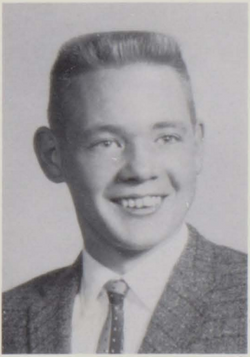
A question placed on Facebook by the Cornell Alumni Association about the Cornell University swim test brought back memories of a group of young men in ties and suits politely eating finger sandwiches and other treats in our living room in September of 1962. The program they were entering was an experimental two-year program for young guys from family farms who were planning on continuing in the profession. My grandfather, John Mapes, had taken what was called the Short Course for young farmers back in the twenties, a program that ran for three winters, so this was not a new idea. My father, Barth Mapes, who had grown up on my grandparents’ dairy farm in the Catskills, was helping to administer the new program. Among the students was a young man named Philip Ives who looked demure in his suit and his blonde brush cut, a haircut that was still prominent at that time, as was the suit. No student of that early part of the sixties generation would have dreamed of showing up in jeans.
Philip was to die only days later while taking the Cornell swim test. This is a test that has been required at many universities, and is still required at Cornell. A number of respondents to the question on Facebook referred to the practicality of requiring a swim test at a school located near so much water, including Cayuga Lake and the various natural pools of water in gorges and near waterfalls. Others joked about the male nudity often required. I knew that male professors swam nude at Teagle Hall, but didn’t know this practice applied to male students. Somehow I ended up on Quora where the practice of men and women swimming nude at other universities and during earlier times was an interesting and surprising subject, but I couldn’t remove myself from what I knew about the young boy/man who raised his hand in the pool at Teagle and sank.
In The Sidney Record And Bainbridge News, the writer gives us a brief description of the events that transpired at Teagle: “He was one of six students being watched by three instructors and one of the instructors immediately brought him out of the pool. Artificial respiration was applied 45 minutes without success. The coroner’s verdict was accidental drowning.” Too many students in the pool at once? It doesn’t sound like there was negligence, however.
Lucrezia Herman alerted me to the Cornell Sun article, “Student Dies in Pool During Swim Test,” dated September 24, 1962, three days after he died. Surprisingly, he did know how to swim: “Ives had already swum the length of the 25-yard pool and was about one-third of the way through his second lap when he suddenly threw up his right arm and sunk to the bottom.” The coroner, Dr. Low, offered the explanation that “the heart can stop ‘within a minute.’ He explained that since evidence of cardiac arrest cannot be detected after death, he has to consider the surrounding circumstances.” He went on to say that taking into account the water in Phillip’s lungs, it was reasonable to look at his death as being due to drowning.
Research on Ancestry.com tells me that Philip was born in 1944, which makes him a war baby. His father’s name was Marvin; his mother’s was Grace. He was buried at Greenlawn Cemetery in Bainbridge, New York, Chemung County. My father was not at the cemetery. Cornell did not let him go. He didn’t have much choice since he didn’t have a tenured position.
My father couldn’t memorialize Philip Ives the way he would have liked, so maybe I can do this in a minor way by remembering him in this post, the eighteen-year-old who ate at our house and died during a swim test not so long after. At the end of the article, his three brothers are mentioned, all of whom graduated from Cornell in the College of Agriculture. Alas, that was not to be for Philip.
Leave a comment